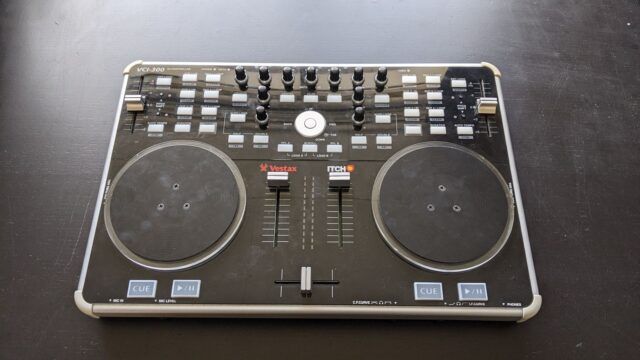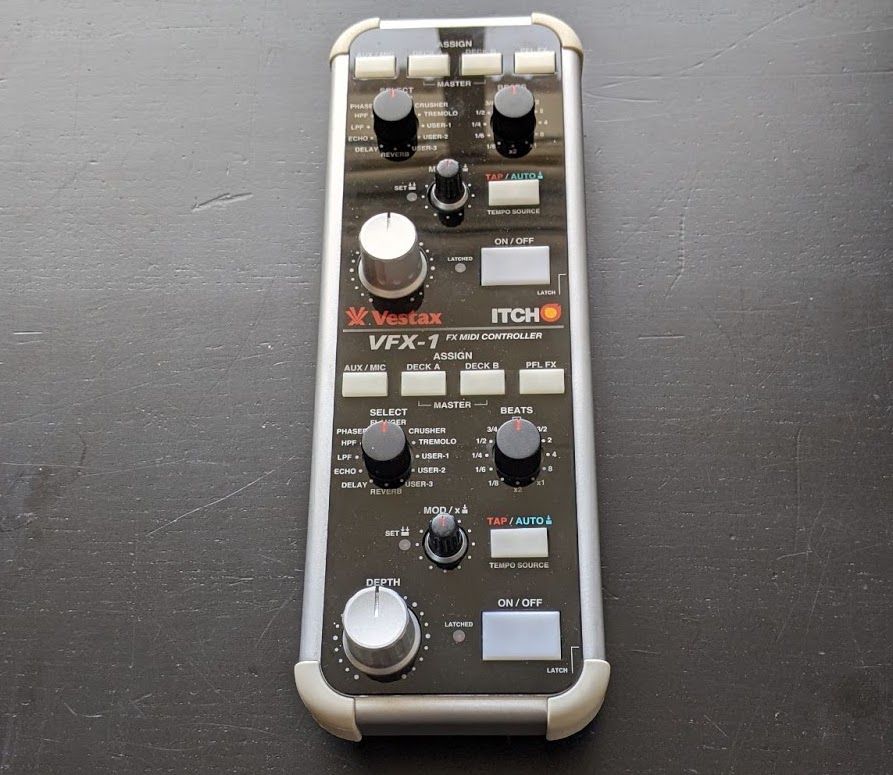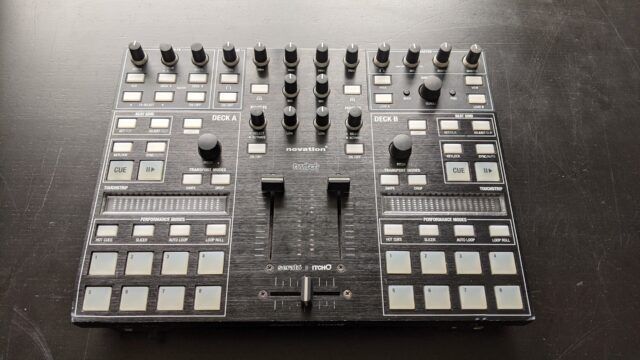Editor’s Note – Over the years, we’ve seen a wide array of attempts to create DJ hardware intended to be the next “big thing”. There was, undoubtedly, much trial-and-error; many companies went for it, with a good idea in mind – and quite a few of them failed. But there are a handful that made an impact – whether good, bad, or something else. Read on, and don’t forget to stay weird.
First, let me introduce myself. I’m Nachtraaf, and I have a knack for unearthing historic, underrated, odd, and meme-worthy DJ gear.
I’m a bit of a hardware geek. Particularly with the advent of controllers, numerous cool (and often crazy) gear concepts have launched – and met an array of fates: they’ve been successful and/or led to more successful gear, were underrated, or simply ended up in the giant pile of e-waste.
But before that, let’s take a few steps back and talk about why I’m here. Well, I got this crazy idea to use gear that played a historic role in shaping the future of DJing when it was released. Some of that gear may have been mentioned on DJTT previously, but didn’t get the attention by the DJ world that I think it deserved. In my eyes, much of this gear was underrated, often seen as oddities, and even includes pieces that were important to me on a personal level. And, of course, we’ll talk about some gear that is just downright meme-worthy.
The Selection Process
Though I don’t necessarily have a set of hard rules on this, I will preface by saying that almost all of the gear in my collection will be controllers, and the majority of pieces discussed are no longer in production. The gear I select must be underrated, odd, or meme-worthy – and somewhat affordable, in this case under €100 (with some exceptions for true, historic gear).
With the constant advent of new gear releases and people trying out new hobbies, there’s a big market for used DJ gear. While DJing is a great activity – sharing music with others, learning new skills, finding new music, and the like – but sometimes, it doesn’t work out at that moment. Many of us have been through a period where the activity just wasn’t that interesting at the time. For some, that’s where their DJ story ends – which usually means gear they purchased was then sold.
That’s where I come in. I search my local marketplace for cool bits of DJ gear and, if the price is right, purchase them. I’ll clean them up, install the drivers, software, and mappings, get them working properly, and do an hour of live streaming on them every first part of my weekly Twitch livestream. So far, I have picked up over 40 different MIDI controllers – and I’m not afraid to use them.
I have picked a few of my favorite pieces of DJ gear in my collection for a little show and tell. I’ll be your sherpa on this adventure. With that – it’s time to dive in.
Vestax: the VCI-300 & VFX-1
What a wild ride this company has had. Starting out in 1977 in Tokyo, Japan, Vestax spent its early years mostly producing guitars and guitar-related products. It slowly started branching out towards DJ gear and found a lot of love. This was especially true in the hip-hop scene, as the PDX series of turntables were great for scratching with their high-torque, straight tonearm, low-weight platter, and features such as ultra-pitch and reverse.
Vestax always pushed the game forward as much as they could. And in that sense, they might just be the most prolific game-changers out there. Sure, not everything they produced was fantastic – but they took a lot of risks, and that is something we currently don’t see enough of. How did the DJ game become so safe? Sadly, with brilliance comes madness; Vestax went bankrupt in 2014, and the DJ world lost one of its guiding gear lights.
The VCI-300

Let’s start out with a bang: Vestax’s VCI-300. Many of you may have heard of this controller, or maybe even have had one. This piece of gear came out in 2008, in the sort of “power vacuum” that existed in a long industry transition between physical media (vinyl, CDs) and digital media (controllers, USBs) DJing.
People switched from physical to digital for an array of reasons, including financial affordability and the appeal of more technical possibilities. While DJing with a computer wasn’t completely new – keeping in mind that Final Scratch launched in 2001, wide-scale adoption just wasn’t there yet. DVS was still more about taking the physicality of records and changing them to a digital format. MIDI controllers took out the middleman.
It was mystical…
The VCI-300 had an air of something mystical about it. There was the sleek design, the next-level jog wheels, and the I/O. One day, I dreamed – maybe one day I would have one. One can dream. Well, that dream turned into a very long hibernation – and come early 2021, it finally came true.
I still don’t really know why, but I decided to check my local marketplace one day – and lo and behold, someone was offering the illustrious Vestax VCI-300. Now mind you, this controller is 13 years old by this time – but it called to me. “Should I?” I really didn’t need it… Compared to my main setup the VCI-300 was not something that I would see much practical use for. But damn it, I had to own one. As a big fan of Vestax (RIP), and owner of a set of PDX-2000s. My very first encounter with turntables was at my old radio station. Because they had a set of PDX-2000s. And those are still going strong. You don’t want to know how much that set got abused throughout the years. So when people say there is 1 brand for liability, don’t underestimate the competition.
…with a sense of nostalgia
Maybe it was a sort of nostalgia for a time I had never really experienced. But taking that piece of gear home, it felt like it was meant to be. I know, that sounds maybe a little odd, and while I’m writing this I feel quite a bit self-aware about that fact, but I now possess a piece of DJ history. Sure, it may not be the most pivotal piece of history ever – but there are enough articles written about those. Instead, I’m here to highlight those that were instrumental.
…and don’t forget the walled garden.
As a long-time Traktor user, I didn’t dabble much in Serato (primarily since Serato locks their software to specific hardware). Even though I have had enough different pieces of hardware go in and out of my collection, none of them were ever certified for it. Since the VCI-300 unlocks Serato Itch (now known as Serato DJ Pro), I could finally try out this piece of software. That was great because I am a big proponent of knowing your way around unfamiliar hardware and software – it’s an underrated skill.
It’s weird, right?
So, why include a much-loved piece of gear? Well, in the current day, the controller market has been consolidated by a handful of brands, and it’s good to look back to the controller that brought many features to the table that we now take for granted. This includes cue points, balance master output, jog wheel tension adjustment, a built-in soundcard, and an all metal body design. This was a controller that didn’t look like a plastic toy. It did many things before they became standardized, and that’s why it made this list.
The VFX-1

Along with the VCI-300 came the VFX-1. It’s a small add-on controller that lets you control the FX section in Serato. Is it a controller? I mean, yes – technically, it definitely is one. But on its own, it doesn’t do much on its own apart from the FX control. While I suppose you can map it in Traktor any way you would like, the layout of it might prove somewhat limiting. This really is a DJ’s “+1 on the guest list”.
Hercules: the DJ Control Air
This French brand was founded in 1982. I was actually quite familiar with Hercules long before I had any of their DJ products. I purchased the Hercules 3D Prophet 4500 Kyro II video card in 2001. They made their first DJ controller back in 2004 with the Hercules DJ Console – which, considering the overarching timeline of DJ gear, actually makes them one of the progenitors in this market.
To be frank, Hercules’ DJ Control Air is a completely middle-of-the-road, cheap, plastic controller. So, why am I talking about it? Well, this one has a special place in my collection. It was my first controller, and the one I started this journey with. It served me quite well. With that, I find that Hercules is a great brand. It’s unlikely they will ever become a top dog in this market, but do they need to? They have a great portion of the market at their price range. At the time of writing this, the Hercules Inpulse 500 is probably one of the best deals you can have starting out as a brand new DJ. We can all praise the top brands in our scene. But I have to respect the brand that lets us take our very first steps.

The one standout feature of this controller was its sensor, which could control different parameters. Such as FX. On paper that sounds like a really cool feature. In practice it turned out that the sensor wasn’t all that great. I tried to make it work, but it just wasn’t in the cards. Combine that with the fact you are standing with your hand waving towards a sensor and people will just give you weird stares about what you are doing. It was a good try. But I haven’t found any controller before or after the DJ Control Air that tried the same concept. I think that might be telling enough.
Novation: the Twitch
A lot of you probably know Novation from their series of synths, keyboards, Ableton controllers. Novation started out in Britain in 1992. While the brand is a powerhouse in the world of production, they first ventured out into the DJ market in 2010, with the much-beloved (especially by turntablists) Novation Dicer (editor’s note: which DJTT’s founder Ean Golden played a substantial part in helping design.
Their next and last venture into the DJ world was in 2011, and pretty much went the exact opposite direction from the Dicers. Enter the Novation Twitch, a revolutionary controller that did away with the jog wheels. Instead of jog wheels there were touch strips, and DJs around the world gasped in horror. How can you use something without round spinny things? Well, Novation did it. Yes, the very next year Vestax had touchstrips on their VCI-380 as well – but it still had jog wheels. It wasn’t until 2013 that we saw another jogless controller implementing a touch strip with the Native Instruments Traktor X1. And as I have found out you can actually scratch on a touch strip. It won’t be very good, but you can.

Powering this thing up with all its red lights, brushed aluminium faceplate makes you think you are utilizing some sort of machine you would see in a James Bond movie. The consumer feedback was very good by those who bought one back in the day. Seeing as this was Novation’s last venture in the DJ market, it’s safe to assume this controller wasn’t the big success it ought to have been. Sometimes it’s difficult to sell a concept that either is too ahead of its time, or people just didn’t grasp the concept. Maybe if they would have made a MK2 version with 2 stereo phono/line inputs to hook up media players to it, it might’ve been a success. Granted even today, where we have the jogless Traktor S5, S8, and D2 controllers that don’t seem to have gotten a large mainstream adoption. Maybe the DJ world will never want to do without round spinny things.
Zomo: the MC-1000
Zomo is a German brand of DJ accessories – furniture, cases, stands, bags, and other items that are slightly more towards the periphery of DJ equipment. Think of their product line as “pretty much anything that doesn’t play music, but you would need anyway as a part of your DJ gear stockpile”. Having started in 2003, it wasn’t until 2012 that they ventured into the DJ market with a controller.
Meet the MC-1000 – a glorious piece of hardware. I find this to be one of the most underrated controllers ever made, especially for the price. It has 4 stereo outs and controls 4 decks. Although it doesn’t have pitch faders, the paddles are perfectly adequate. Without the stand, it fits in front of a standard 4-channel mixer. With the stand, it fits behind the mixer. Media players, whether vinyl or digital, are solid – but if you want to control 4 decks and barely take up any space, this thing cannot be beat. The knobs feel great, very smooth like on a high-end mixer. And the buttons feel like they were ripped directly from a media player.

Similar to the scenario with the Novation Twitch, it feels odd to praise a piece of hardware that was a company’s only entry into the DJ controller world – and one that probably let a sour taste in their mouths. However, these are such underrated gems that likely just didn’t sell enough to warrant any successors. It’s a shame, but sometimes you take a risk and it simply doesn’t work out.
DJ-TECH: the DJ Mouse
Looking for something affordable? I don’t think you can get a much better deal than DJ-Tech. While I’ll admit I have never tried their series of scratch mixers (DIF-1S, DIF-2S, Handy Kutz, etc), it’s hard to argue that getting a 2-channel scratch mixer with an Innofader Mini for the price they are selling (usually under €200) is fantastic value. But they have a few odd pieces under their belt as well.
With that, let’s take a look at the DJ Mouse (psst – here’s a throwback to when we first discovered this gem at DJTT back in 2009). It is a computer mouse that is also a DJ controller. This to me is the pinnacle of DJ gear. If you do not possess the DJ-Tech DJ Mouse, can you really even call yourself a DJ? This is where it is truly at.
In conclusion: these are risks worth taking.
There’s no doubt that this round-up of oddities is a great source of laughter.
But at the same time, let’s remember that these designers and companies took risks, made products, and dealt with all the consequences that came with it. Will it be successful? Will it bankrupt your company? You can’t really say. Getting out there and doing things differently is, in essence, what it means to be a DJ. The hardware also reflects onto us in some sense. Do we want to do the safe thing, stay in the safe lange, never take a risk – or will we venture out and take that risk?
Maybe we will fail in the process, and maybe we’ll fail a hundred times. 10 years ago, innovation in the DJ scene was wild; you’d oftentimes show up to a gig and not know what gear you’d discover. To me, while that fills me with absolute dread, it is also thrilling. You get to try out new things, as you’re given an opportunity to shake things up and get out of the routine.
After all, progress is made when you get out of your comfort zone.
There are many pieces of gear in my collection. If you stick around, I just might tell you about some more. After all, we’ve only just scratched the surface.
So, what do you think? Any other gear you’d like to see on this list? In the meantime, keep up with Nachtraaf on Twitch, Mixcloud, Facebook, Instagram, & YouTube.





